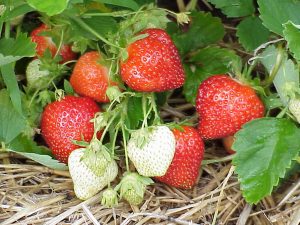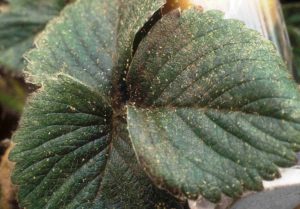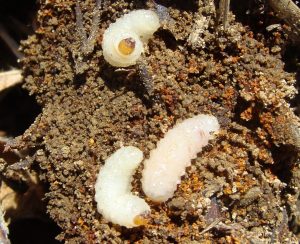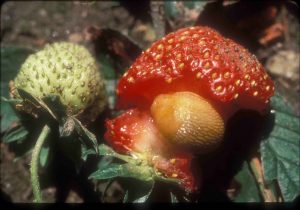Strawberry IPM Newsletter No. 4 – June 9, 2017
 Strawberry IPM Newsletter No. 4 – June 9, 2017
Strawberry IPM Newsletter No. 4 – June 9, 2017
Click on photos to enlarge.
STRAWBERRY INSECT PEST PRESSURE REMAINS LOW
Continue Protection Against Gray Mold through Bloom
Berry Growers Twilight Meeting
Tuesday, June 13, 2017 at 5:30 p.m.
Lavigne’s Farm in Sanford, Maine 04073
Venue phone: 207.324.5497
Situation:
Cool, wet weather continues to slow plant and flower development throughout the state. Many “early” fields are still in the full-late bloom stage, except in southern Maine where some green fruit is visible in early fields. Insect pest pressure has generally been low, but warmer, drier weather could bring about rapid changes in the situation. The high levels of moisture mean increased pressure from fungus diseases, so keep flowers and fruit protected with timely fungicide sprays any time significant precipitation is predicted during the bloom period.
Don’t forget! Twilight Meeting Tuesday June 13, Lavigne’s Strawberry Farm, 158 Whichers Mill Road, Sanford, Maine 04073. Albert and Patrick Lavigne’s farm features large strawberry and high bush blueberry plantings. We’ll have a tour of the berry fields and have an opportunity to look over the equipment they use in their operation. The meeting will run from 5:30 p.m. to 7:30 p.m. Two pesticide applicator recertification credits will be available for attending the meeting.
Strawberry bud weevil or “clipper” remains low for this point in the season, with just two fields finding any clipper and only one of those over threshold. Most fields in southern Maine that are now passing full bloom are beyond the stage where clipper can cause significant damage, but if you still have late varieties with flowers still in bud, continue scouting for damage. Clipper damage is likely to increase on late varieties as temperatures get warmer in the coming days. Raspberry and blackberry growers should also scout for clipper damage; clippers will also attack the buds of these plants.
Tarnished plant bug activity continues to be very low. We have seen occasional adult bugs in the fields, but no nymphs were found this week. However, with the warmer, drier weather forecast, and more fields coming into bloom, fields should be scouted regularly and often for both adults and nymphs. The control threshold for nymphs is 4 or more flower clusters infested per 30 sampled.

Two-spotted spider mites were found over the spray threshold (25% infested leaves) in two southern fields this week, while another field was just under threshold. Expect populations to increase in the coming days as conditions become warmer and drier. It is important to scout for mites regularly, because they can increase rapidly when conditions are favorable.
Black vine weevil and strawberry root weevil:
As we approach the harvest season remember that this is the time when adult black vine weevils and strawberry root weevils to begin to emerge and start feeding on strawberry foliage. Look for notching along the leaf edges and the presence of the black or brown snout beetles. The weevils feed mostly at night and spend the daylight hours at the base of the plants under the mulch. They will be laying eggs during the harvest and post-harvest period. The larvae or grubs feed on the strawberry plant roots through the fall, overwinter deep in the soil and feed again in the spring, causing plants to weaken and die. Badly infested beds should be plowed up as soon after harvest as possible. Bifenthrin (Brigade®) can be applied to kill the adults when they emerge and start to feed on the leaves (usually until mid-late July). Applications should be made at night when the insects are active, and the highest rate of the insecticide should be used. Platinum® can be applied in the fall as a soil drench to control grubs before they go into the winter.
- Black Vine Weevil; photo by David Handley
- Strawberry Root Weevil Grub; photo by David Handley
White grubs are the larvae of scarab beetles, including Japanese beetles, Asiatic garden beetles and European chafers. Similar to the root weevils, the grubs feed on the roots of strawberry plants, but these tend to be larger, have noticeable legs and a swollen back end. White grubs are pupating now, and adults are beginning to emerge. These will soon be laying eggs at the base of the strawberry plants and a new generation of grubs will appear during the late summer and fall. Soil drenches with Admire Pro® or Platinum® can provide control of grubs in new plantings or following renovation in older plantings. Parasitic nematodes may also be applied in the spring and/or fall. See the New England Small Fruit Management Guide for details.
Slugs may be a problem in some fields this season. Moist conditions encourage the presence of these mollusks. Slugs usually feed at night, leaving large holes and tunnels in ripening fruit. Baits such as Deadline® and Sluggo® offer some control of slugs, but should be used prior to fruit ripening. Pay close attention to label instructions and precautions. Baits should also be applied to the fields in mid-September if slugs have been a problem, to reduce egg-laying.
- Slug on Strawberry; photo by James Dill
- Gray Mold on Strawberries; photo by James Dill
Diseases: Most growers are continuing to use fungicides to protect flowers from gray mold spores. So many wet days during bloom has made keeping adequate coverage challenging. We typically find two to three fungicide applications during the bloom period adequate, but with a very extended bloom and lots of moisture, additional sprays have been needed in many fields to prevent infection.
Anthracnose fruit rot: As fruit starts to size up and ripen in fields that are wet from recent rains, be on the lookout for this fruit rot. Anthracnose is favored by warm, humid conditions and can spread rapidly under rainy, wet conditions, especially if puddles remain in a field after the rain. Anthracnose appears as black sunken lesions with wet, orange (and sometimes gray) spore masses in them. The fungus is able to multiply on leaves without visible symptoms, which is why it may appear suddenly and widespread in a field. Fungicides such as Cabrio® and Abound® can provide good control of anthracnose fruit rot.
Powdery mildew: No severe symptoms of powdery mildew have been observed yet, but expect to see the problem become more noticeable with warmer, dry conditions. Look for upward cupping of the leaves and reddish streaking or lesions on the leaf and flower stems. Consider using a fungicide that will control powdery mildew, such as captan + Topsin-M®, or Pristine® if you’re still spraying for gray mold.
REMINDERS:
Protecting the endangered rusty patched bumble bee as well as other pollinators of berry crops will be the topic of a meeting sponsored by Cooperative Extension, the Wild Blueberry Commission of Maine, and US Fish and Wildlife Service on Wednesday, June 21, 2017 at 6:00 PM at the Waldoboro Cooperative Extension Office. For more information contact Dave Yarborough at 1.800.897.0757.
2017-2018 New England Small Fruit Management Guides now available. Copies can be purchased through UMaine Extension at Highmoor Farm. Cost of the guide is $12.00 plus $2.63 postage for a total of $14.63. Please send checks made payable to UMaine Cooperative Extension and mail to: Highmoor Farm, P.O. Box 179, Monmouth, Maine 04259, atten. Pam St. Peter. For more information, contact Pam St. Peter at 207.933.2100 or pamela.stpeter@maine.edu.
Sincerely,
David T. Handley
Vegetable and Small Fruit Specialist
Highmoor Farm, P.O. Box 179, 52 US Route 202, Monmouth, ME 04259, 207.933.2100
UMaine Extension Diagnostic Research Lab, Pest Management Unit, 17 Godfrey Drive, Orono, ME 04473, 1.800.287.0279
Where brand names or company names are used it is for the reader’s information. No endorsement is implied nor is any discrimination intended against other products with similar ingredients. Always consult product labels for rates, application instructions and safety precautions. Users of these products assume all associated risks.
The University of Maine is an equal opportunity/affirmative action institution.




